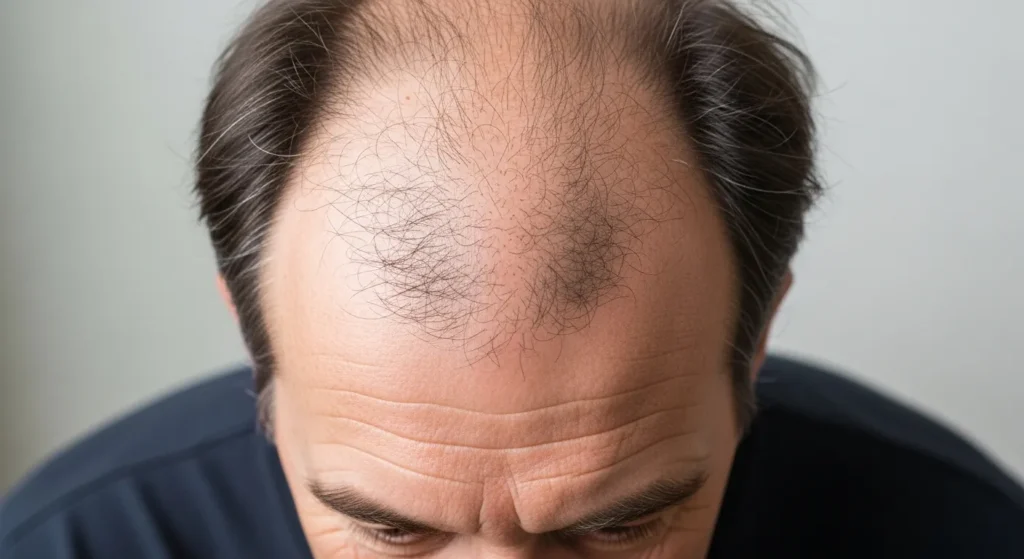Noticing sudden hair shedding after your hair transplant? You’re not alone. Shock hair loss after hair transplant—also known as postoperative shedding—is a common and temporary condition that can alarm even well-informed patients.
In this blog, we’ll explain why it happens, how long it lasts, and what you can do to encourage healthy regrowth. Backed by medical insights and real recovery timelines, this guide provides the clarity and reassurance you need to confidently move forward in your hair restoration journey.
What Is Shock Hair Loss After Hair Transplant?

Definition and Medical Explanation
Shock hair loss refers to the temporary shedding of native or transplanted hair following a hair transplant procedure. It typically occurs due to trauma or stress on the scalp caused by surgical incisions, anesthesia, or the healing process.
It’s a form of telogen effluvium, where hair follicles enter a resting phase and shed before restarting a new growth cycle. This condition is expected and not a sign of transplant failure.
Is It Normal or a Sign of Failure?
Yes, shock loss is completely normal. It affects a significant percentage of patients and usually resolves within a few months. The transplanted grafts remain intact beneath the scalp and will start producing hair again.
However, if excessive loss persists beyond 4–6 months, it should be evaluated by your hair restoration specialist.
How It Differs from Typical Hair Shedding
Unlike everyday shedding (50–100 hairs per day), shock loss often happens in clusters or patches and is more noticeable, especially in the recipient or donor area. It can also involve temporary thinning of native hair, not just transplanted follicles.
What Causes Shock Loss After a Hair Transplant?
Trauma to the Scalp During Surgery
During procedures like FUE or FUT, the scalp undergoes minor trauma. Even though it’s minimally invasive, the micro-incisions can stress surrounding follicles, triggering temporary hair fall.
Blood Supply Disruption
The redistribution of blood flow to newly transplanted grafts may temporarily reduce nutrients to nearby hairs, causing shedding.
Telogen Effluvium Trigger
The physical and emotional stress of surgery can activate telogen effluvium, a hair cycle disruption that causes sudden shedding.
Factors That Increase Risk
- Pre-existing thinning around the transplant area
- Aggressive surgical technique or over-harvesting
- Post-op infections or inflammation
- Poor post-operative care
- High stress, smoking, or nutritional deficiencies
When Does Shock Hair Loss Occur?
Timeline Overview (Days to Weeks Post-Op)
Shock loss typically begins between 2–4 weeks after the procedure. It may continue for a few weeks before tapering off.
Donor vs. Recipient Area Shedding
- Recipient area: Usually involves transplanted follicles entering the rest phase.
- Donor area: May show temporary thinning due to trauma or overharvesting.
- Both areas generally recover fully within a few months.
Temporary vs. Permanent Shock Loss
In most cases, shock loss is temporary. However, if existing native hair was already weak due to androgenetic alopecia, the shedding may become permanent. This is rare and can be minimized by strategic transplant planning.
What Does Shock Loss Look Like?
Visible Signs and Symptoms
- Sudden patches of hair shedding
- Thinning around the recipient zones
- Redness or mild irritation
- Tiny scabs from graft sites
How to Tell It Apart from Graft Failure or Infection
| Condition | Signs |
|---|---|
| Shock Loss | Hair falls but skin looks healthy |
| Graft Failure | No regrowth after 4–6 months |
| Infection | Hair falls, but skin looks healthy |
How Long Does Shock Hair Loss Last?
General Recovery Timeline
| Post-Op Time | Hair Condition |
|---|---|
| 1–3 weeks | Initial healing, scabs fall off |
| 3–8 weeks | Shock loss occurs |
| 2–4 months | Early regrowth begins |
| 5–6 months | Noticeable growth in treated areas |
| 8–12 months | Final results become visible |

Individual Variation
Recovery varies depending on:
- Surgical technique (FUE vs FUT)
- Patient age and health
- Post-op care adherence
- Pre-existing hair health
When You Should See New Hair Growth
Most patients start seeing new hair sprouting around month 3 or 4, with noticeable improvements by month 6. Full results appear around 12 months post-surgery.
How to Reduce the Risk of Shock Hair Loss
Pre- and Post-Surgery Best Practices
- Follow pre-op instructions (avoid blood thinners, alcohol)
- Keep your scalp clean and moisturized post-surgery
- Avoid sleeping face-down
- Take prescribed antibiotics or anti-inflammatories
Avoiding Stress, Smoking, and Heavy Exercise
These factors can impair healing and increase shock loss:
- Smoking reduces oxygen flow to follicles
- Heavy workouts cause sweating and irritation
- Stress increases cortisol, disrupting the hair cycle
Choosing an Experienced Surgeon
A certified and experienced surgeon will:
- Use gentle techniques
- Minimize trauma
- Strategically place grafts
- Offer personalized post-op care
Treatment Options and Management
What to Do If You Experience Shock Loss
- Don’t panic—shedding is expected
- Be patient; recovery takes time
- Stay in touch with your surgeon
Role of Minoxidil or PRP Therapy
- Minoxidil (Rogaine): May help accelerate regrowth, but should only be used with medical advice
- PRP Therapy: Boosts healing and follicle stimulation
Supplements and Hair Growth Products
- Biotin
- Zinc
- Omega-3 fatty acids
- DHT blockers (consult with a specialist first)

When to See a Specialist
- No new growth after 5–6 months
- Bald patches continue worsening
- Signs of inflammation or infection
Common Emotions and Mental Health Considerations
- Temporary shedding can cause anxiety or regret
- Open communication with your surgeon eases fears
- Consider support groups or counseling if distress persists
Frequently Asked Questions (FAQs)
Is shock loss permanent?
No. It is usually temporary. Hair regrows in 3–6 months.
How long does it take for hair to grow back?
Initial regrowth begins by month 3–4, with full results in 12 months.
Can donor hair fall permanently?
Rarely. Most shock loss in the donor area is temporary unless overharvested.
Is shock loss more common with FUE or FUT?
Both can cause shock loss, but FUE is generally less traumatic and may reduce the risk.
How can I speed up recovery after shock hair loss?
Avoid stress, follow aftercare, and consider PRP or minoxidil with doctor approval.
Take Your Next Step
Worried about post-transplant hair shedding?
Get expert guidance and reassurance from Dr. Rana Irfan, one of Pakistan’s leading ABHRS and ISHRS-certified surgeons.
Book your consultation in Islamabad today and ensure a safe, confident recovery.
